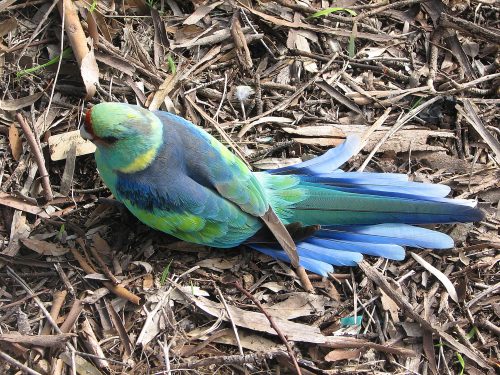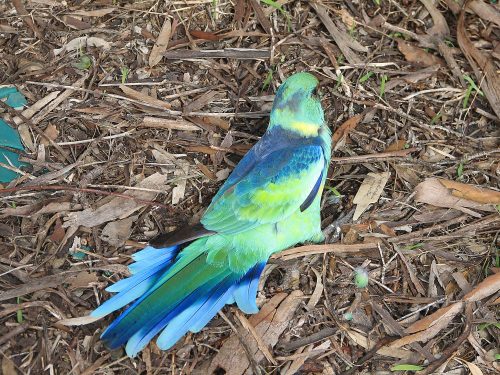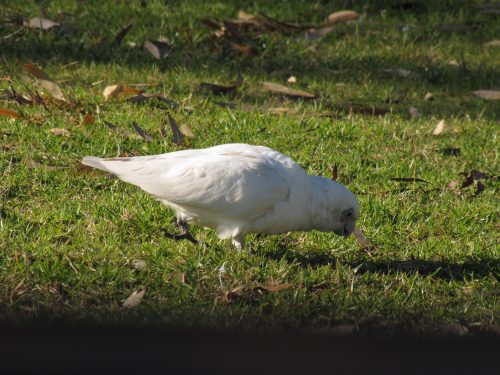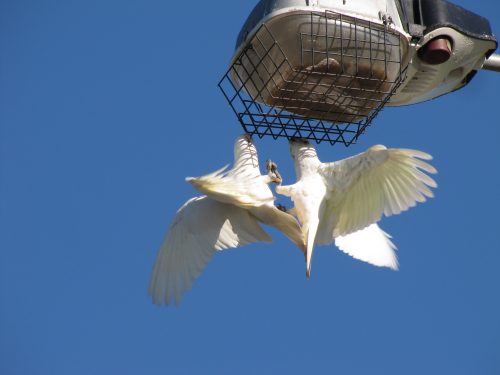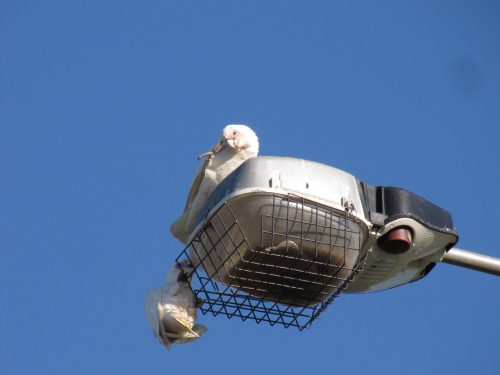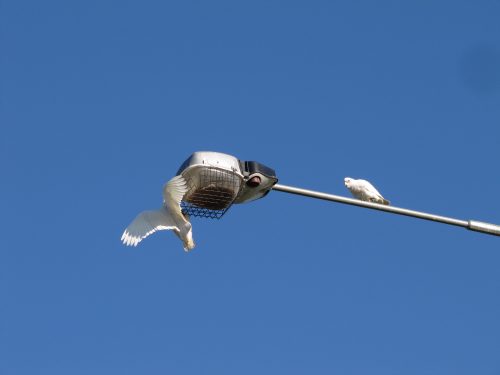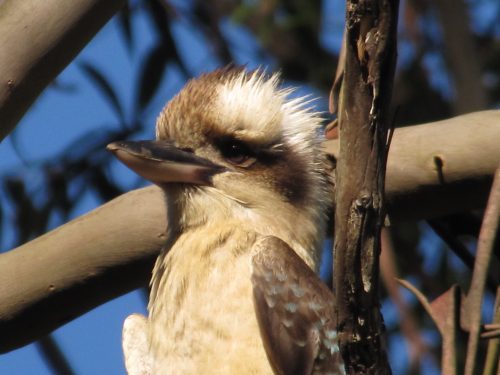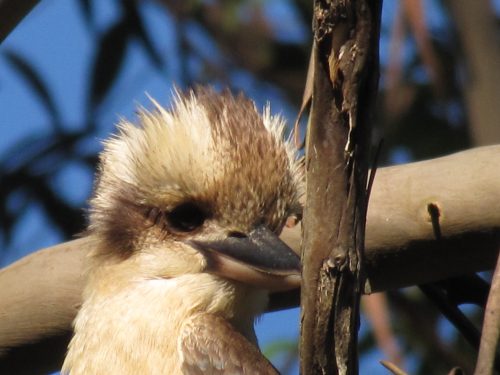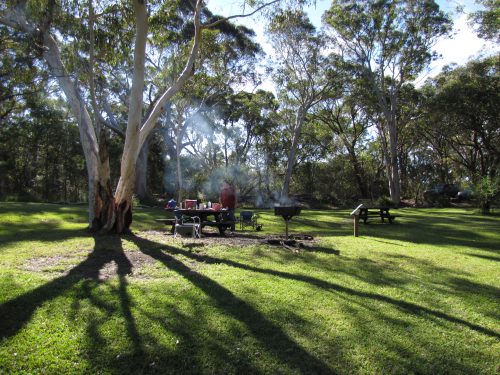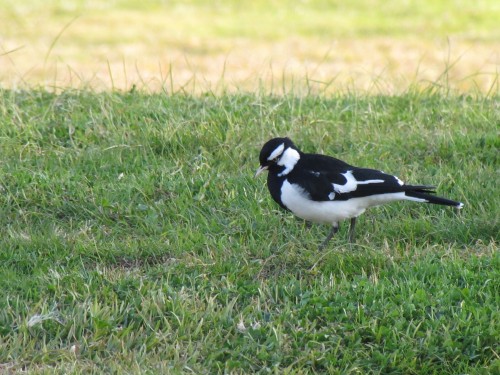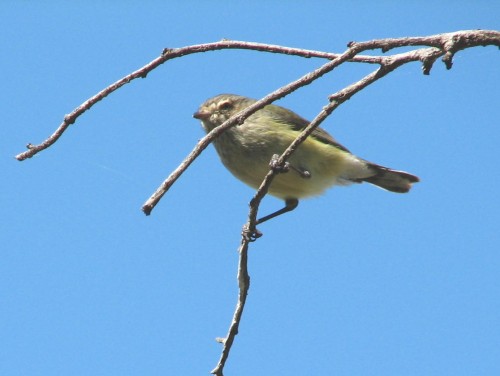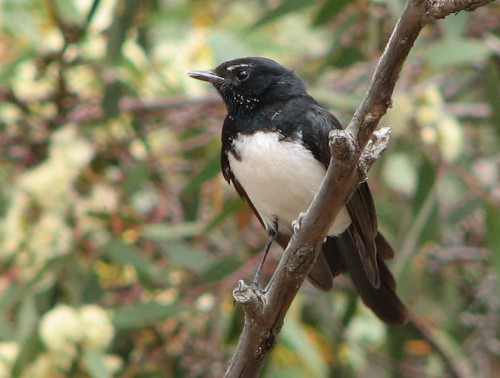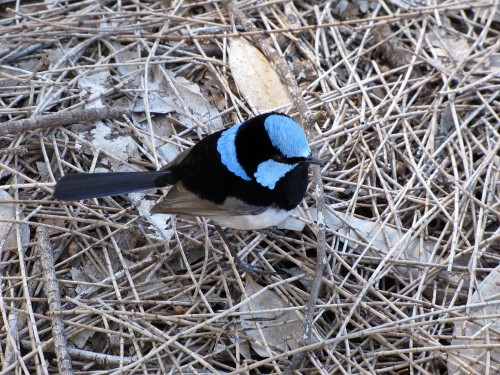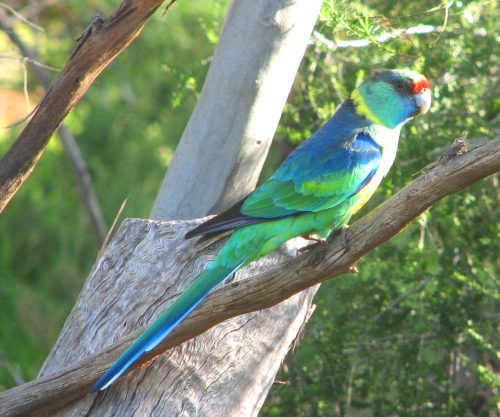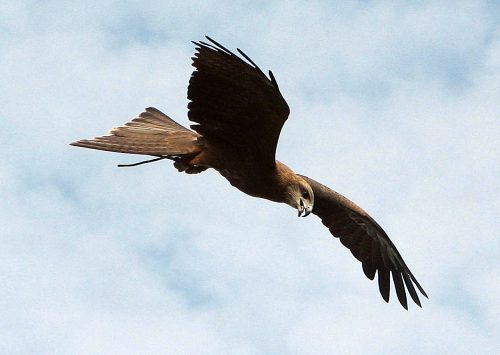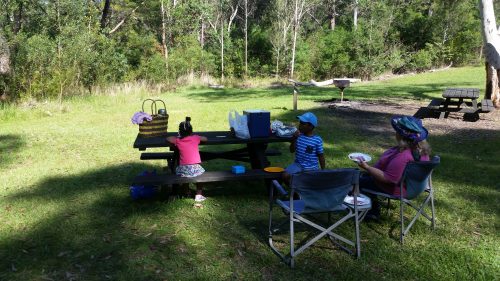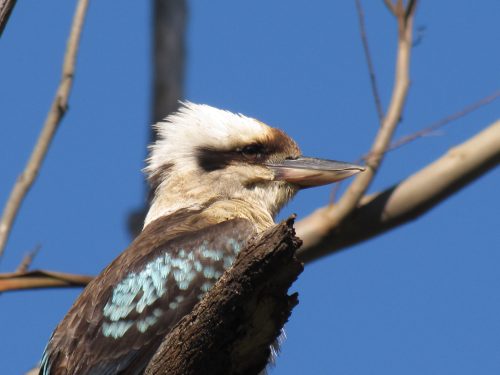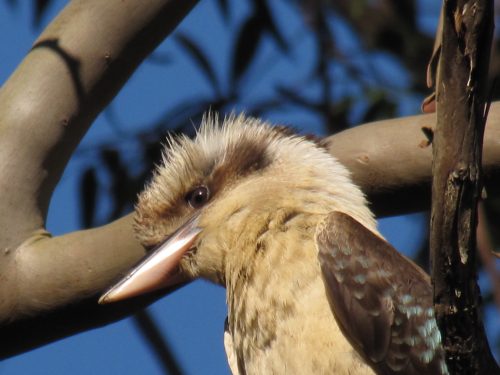Beautiful Mallee Ringneck Parrots
Over recent years we have had a family of Australian Ringneck parrots move into our garden. Before that, they were only occasional visitors, but now we see – or hear – them every day. They can be raucous at times. I now consider them to be a resident breeding species in our garden. In fact, only last week I witnessed two of them mating, so we could have even more around in the next few months. They have been constantly investigating a large hollow in one of our mallee trees. The birds we have here are the sub-species Mallee Ringnecks.
At first, we only had two birds, but after breeding, there were more, and now we often count up to about eight birds in our garden, or in the nearby mallee scrub. They chatter away noisily in the nearby trees, often disturbing the peacefulness of our edge of town block of land. We don’t really mind because we love having them around. That is – until they attack our ripening pears, chewing around the stems of each piece of fruit. Each summer I have to drape netting over the trees to minimise the damage.
Last week I was going out the sliding door on to our back veranda. I was heading out to sit in the weak winter sun to do some reading. One of the parrots flew from the nearby tree towards the house just as I came out of the door. It was flying directly towards me, wings and tail spread out fan-like as it came to a stop, landing on the edge of the roof guttering. As the feathers spread out, I glimpsed the beautiful colours of this lovely bird. Sadly, I didn’t have my camera – it happened far too quickly, anyway.
The photo at the top of this post shows the colourful feathers of one of our birds which accidentally flew into my office window last year. It sat on the ground quite stunned for a few minutes before flying off again. The photo below shows another shot of the same bird.
Further reading:
Corellas: Villains of the Bird World
Birding time out
From time to time I take out a few minutes from my day to go birding. Sometimes these few minutes stretch into a few hours. I recently took off a whole afternoon. During this time, I visited six birding spots around my home town of Murray Bridge which is about an hour’s drive south-east from Adelaide.
Sturt Reserve
One of the spots I visited was Sturt Reserve. This lovely spot is on the banks of the Murray River. It is named after Captain Charles Sturt who explored the river in 1830. The reserve has large areas of lawn for picnics, a large playground and a restaurant. It also plays host to a wide variety of birds.
Little Corellas
On my recent visit, there were quite a few Little Corellas in the trees along the river. In flocks of 30 – 50 they can be annoyingly noisy. In recent years, these flocks have grown into the hundreds on many occasions. They are known to be high on the list of the Villains of the Bird World.
Havoc
In large flocks like one can see at Sturt Reserve – and other spots around the district – they can wreak havoc on trees, stripping leaves, twigs and bark from trees until little is left but for a carpet of gum leaves on the ground below. The nearby lawn-tennis courts have also been a target of these destructive birds. They have sometimes left the courts unusable after the sharp beaks of several hundred birds have visited. Various methods to disperse the flocks have been tried, but without much success. This is a widespread problem in many places in South Australia.
Large flock
Later, I drove a few kilometres to the southern edge of town to visit Swanport Reserve, also on the banks of the river. Here I witnessed flocks of several hundred corellas flying along the river and then out onto recently cultivated farmland across the river. Because of the distance, I was only able to estimate their numbers. After many smaller flocks had joined into one large flock, there must have been at least 1200 birds – possibly as many as 2000.
The photos below were taken at Sturt Reserve. They show the playfulness of some of the birds on the street lights. While I couldn’t see any damage to the lights from their beaks, they are quite capable of causing the local council some expensive headaches.
Further reading:
Lunch snatching Kookaburra
Recently I have written about our trip to Sydney last month. I am a bit behind with sharing my sightings and photos on that trip, so I had better rectify that in the coming days. Actually, it will probably be over the coming weeks because I have so many photos and experiences to share, especially on the trip home.
On the second last day of our visit to stay with our son, we all decided to have a family picnic at the nearby Lane Cove National Park, about a ten-minute drive from my son’s home – depending on the traffic. My wife and I had taken the grandchildren there a few days earlier. They were keen to have barbequed sausages and try their hand at cooking marshmallows on the coals after lunch.
All was going well. We found a lovely spot with no other people around. We were able to easily get a fire going. Soon the sausages were cooked and we enjoyed our lunch.
“Keep an eye on those kookaburras,” warned Nanna.
There were about five or six Laughing Kookaburras perched in the trees nearby. they were all watching our movements keenly. One of the birds was perched right above our picnic table. We were annoyed when one of them decided to “decorate” the table below. Thankfully, his efforts missed our food.
Just as my son was about to take the last sausage off the plate, one of the birds swooped down and deftly snatched the last sausage. It had obviously done this cheeky manoeuvre many times before, never hesitating and expertly snatching the sausage off the very hot plate in its downward swoop. It didn’t stop but continued off into the forest, hotly pursued by the rest of the “gang” of thieves. We didn’t see where they went to devour the food, but we certainly heard plenty of protesting and squabbling as they fought over their ill-gotten gain.
While we were annoyed by their theft, it was wonderful for our grandchildren to be there to witness nature in the raw like that.
Despite our loss, we had all eaten well and enjoyed our picnic on a lovely sunny autumn day.
Good birding,
Trevor
Lunch time birding
Fine weather
It is autumn here in southern Australia and this is the favourite season of ours. We generally have very little wind, a few cloudy days but the majority of days are chilly in the morning with occasional frosts, followed by a sunny day. On lovely days my wife and I love to sit out on our back veranda to eat our lunch. This part of our house is overlooking our garden and the nearby mallee trees. It can be a perfect spot to do some birding without disturbing the birds going about their normal daily activities.
Binoculars
In recent days I have taken to also wearing my binoculars while I eat. I must say that I do more birding than eating in this way. The food eventually gets consumed but the interruptions are frequent. Today was a particularly good day with an interesting range of birds. Possibly the most common species in our garden would have to be the House Sparrows and the Common Starling, two introduced species here in Australia.
We also have many Weebills and Yellow-rumped Thornbills. About a dozen of these beautiful thornbills few past only a few metres from where we sat, calling to each other as they flew. The Weebills are harder to see because they tend to forage in the tree-tops and are sometimes hard to pick up as they move in the foliage. Their call is hard to miss, however. It is a similar situation with both the Striated Pardalotes and the Spotted Pardalotes: hard to see but easy to hear.
Talking about calls, one of the more strident bird calls we experience here is the Australian Magpie-lark, shown in the photos at the top of this post. We had two in the garden today but they hardly made a sound. In fact, the female sat in a nearby tall mallee tree preening itself for most of the time we were sitting there. Not a call to be heard and I nearly missed listing her for my database. Also quite inconspicuous today were the resident Australian White-backed Magpies, heard just over the neighbour’s fence but not actually seen during our lunchtime break.
At one stage I commented to my wife that I hadn’t seen the White-browed Babblers in a while. The local family must have heard my comment because a group of about eight flew past a few minutes later, their mewing calls unmistakeable. In the distance, I could hear several Little Ravens calling, and one of them came quite close, investigating the trunk of a nearby tree and looking under the bark for a few beetles or spiders for lunch.
One of the notable birds missing today was the resident Willie Wagtails. I didn’t see either of them, nor did I hear them. That can happen sometimes and I guess that they were feeding some distance away from the house – perhaps on the other side of the building. Or they might have been out in the paddock because we live on a five-acre block. I was also surprised by the lack of honeyeaters. I saw several White-plumed Honeyeaters and a few Red Wattlebirds, but the usually noisy and bossy New Holland Honeyeaters were nowhere to be seen – or heard. Strange.
Over the last five years, we have been delighted to have a family of Superb Fairy-wrens resident in our garden (photo above). We take great delight in seeing them hopping around, flitting from bush to bush or feeding out in the open. Today the family of five – there may be more – were investigating the puddles of rainwater on the swimming pool cover. Several of them even tried it out by having a quick bath. Who needs to supply bird baths?
Every day we have plenty of parrots in our garden – either landing in the trees or flying overhead. We have a noisy group of Mallee Ringneck parrots (photo above) which we see and hear every day so I class them as a resident species. Today we also had several small groups of Rainbow Lorikeets fly overhead. In recent weeks they have been feeding on the flowering mallee trees, but today they just flew over screeching as they went. The local Galah population often lands in some of our trees but today they just flew over in loose flocks numbering from about six to forty.
At one point I actually put down my food and walked quickly out from the veranda to get a better view of two birds gliding high overhead. At first, I thought they were Wedge-tailed Eagles, mainly because they were so high. On closer inspection using my binoculars, I could see that they were Black Kites (see photo above), common in this area but one species I hadn’t seen near our home for quite some time.
In all, I saw or heard 22 species during the half hour lunch break. This is not a huge number, but it was a satisfying break despite that.
I would love to hear about the birds in your garden – use the comments section.
Good birding,
Trevor
That’s not what I expected
Yesterday, my wife and I took our two grandchildren, ages 8 and 5, on a picnic. We are currently staying with them here in Sydney during the school holidays. They are very energetic children and they needed to run off a little steam, so we took a picnic lunch, some balls, my binoculars, my grandson’s binoculars(he is starting to develop an interest in birds), our folding chairs, my camera and a thermos for a cuppa. And some treats from our favourite local bakery.
Lane Cove National Park
We drove the short 10-minute journey to this wonderful national park, just a short distance west of Chatswood. We set up for our picnic and enjoyed some barbecued sausages and the treats from the bakery. It was a clear day with the temperature in the mid-20s – perfect for a picnic. After lunch, we involved the children in a few games. These included searching for various natural objects such as finding three different kinds of leaves. They were quite entertained, especially when I suggested some running races. They are both excelling at Little Athletics so they enjoyed making up a short course and getting me to time their efforts while I had my cuppa. Too easy.
Slow birding
Meanwhile, the birding side of things was rather slow. Sure, the obligatory Laughing Kookaburras were perched nearby, just waiting for an opportunity to sweep down and snatch our food (see photos below). Small flocks of Rainbow Lorikeets streaked overhead, or squabbled noisily in nearby flowering gum trees (eucalypts). We heard the occasional Pied Currawong calling, along with several Australian Ravens. Two Australian Black-backed Magpies were quietly feeding on the grassed area opposite us, and I heard a number of Yellow-faced Honeyeaters in the nearby trees, though I did not get a good look at them. All very quiet and peaceful – just right for a relaxing afternoon.
An unexpected bird
Just as I was finishing my cuppa, a small flock of Noisy Miners (a native honeyeater species) started calling very noisily near the top of a nearby tree. I stood up and moved closer, training my binoculars on the spot where a hawk-like bird had landed. It was being severely harassed by the miners. I raised my binoculars and immediately identified it as a Pacific Baza. I had a good view for several seconds, long enough to identify it and to take a few photos before it flew off.
Photos
Alas.
My camera was twenty metres away on the picnic table next to where I had been sitting – so no photos.
Botheration!
In my haste to see the bird, I had clean forgotten to pick up my camera. This is rather sad because I would have loved to have taken a photo of this species. This is only the second time I can recall seeing this bird; the other time was several decades ago in northern New South Wales, well before I started bird photography. I cannot be absolutely sure about this earlier sighting because all of my notebooks are at home, some 1400 km or two days’ drive away.
Pacific Baza
This species is found along the coastal regions of New South Wales, Queensland, Northern Territory and northern Western Australia. It is quite common locally but on this occasion, I only saw the one individual. This is about the southernmost extension of its range, and they are rarely sighted south of Sydney.
They are one of Australia’s easiest hawk species to identify, with a small crest and bright stripes across their chest. You can see several photos here, as well as more information about the species.
Meanwhile, here are two photos of the Laughing Kookaburras which sat watching our food in the hope of snatching something.
Good birding,
Trevor
